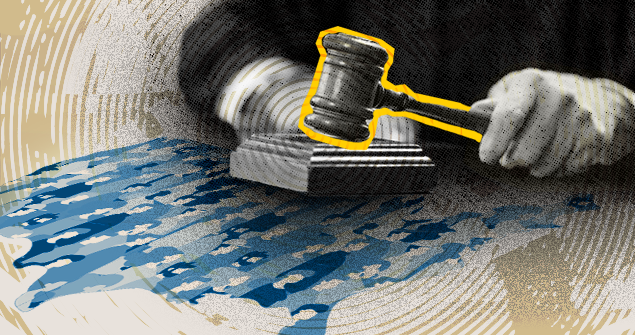
State Supreme Court Diversity — May 2023 Update
State supreme court benches fail to reflect the racial, ethnic, and gender diversity of the communities they serve and the diversity of the legal profession.

Part of
In July 2019, the Brennan Center for Justice published State Supreme Court Diversity, which detailed stark racial, ethnic, and gender disparities on state high courts across the country, drawing on more than 60 years of data. This year, we updated the analysis with data on the composition of state supreme courts as of May 15, 2023, including updated information on justices’ demographic and professional backgrounds. For the first time, we are also including data on the District of Columbia Court of Appeals, the highest court in Washington, DC. This report was previously updated in May 2022, April 2021, and February 2020.
These are the key findings since our last analysis:
- In 18 states, no justices identify as a person of color, including in 12 states where people of color make up at least 20 percent of the population.
- There are no Black justices in 24 states.
- There are no Latino justices in 40 states and DC.
- There are no Asian American justices in 42 states.
- There are no Native American justices in 47 states and DC.
- Across high courts in all 50 states and Washington, DC, just 20 percent of state supreme court seats are held by people of color. By contrast, people of color make up over 40 percent of the U.S. population.
- Men hold 58 percent of high court seats.
- In 6 states, there is only one woman on the supreme court bench, and in South Carolina, there are no women state supreme court justices.
- Thirty-eight percent of sitting justices are former prosecutors, while only 9 percent are former public defenders.
Recent Changes
Since we last collected data in May 2022, 32 new justices have joined state high court benches: 8 by election and 24 by appointment. There are currently 5 vacant state supreme court seats.
As a whole, this year has brought a slight increase in demographic and professional diversity across state supreme courts. Excluding Washington, DC, where we do not have 2022 data, the percentage of people of color on state high court benches increased by 1 percentage point to 19 percent. The percentage of women likewise increased by 1 percentage point to 42 percent. In some states, high courts achieved milestones for diversity. For example, the Illinois Supreme Court bench now has a majority of female justices for the first time in its history. Illinois, Nevada, and Michigan swore in Black women justices for the first time in history, and Nevada swore in its first Asian American justice. However, other states became less diverse along key measures. South Carolina, for example, now has an all-male state supreme court bench.
Of the new justices this year, 15 are women and 17 are men. Twenty-five of the new justices are white, including in 13 states where people of color make up at least 20 percent of the population (Alabama, Alaska, Delaware, Illinois, Indiana, New Jersey, New York, North Carolina, Ohio, Oregon, South Carolina, Utah, and Virginia). Six of the new justices are Black, and one, Justice Patricia Lee of the Nevada Supreme Court, is African American and Korean American. All the new nonwhite justices reached the bench through a judicial appointment, not an election. In seven states, Alabama, Alaska, Delaware, Indiana, Kentucky, North Dakota, and Utah, one or more new white justices joined already all-white benches.
Eight of the new justices have prosecutorial experience, and six of the new justices are former public defenders.
Note: Janet Protasiewicz, who was elected to the Wisconsin Supreme Court on April 4, is not included in the data set because she had not been sworn in as of the cutoff date for this analysis and her predecessor is still seated on the court. Sandra Slack Glover, who has been nominated to the Connecticut Supreme Court, is not included in the data set because she has not yet been confirmed by the Connecticut General Assembly. Michael Noriega, who has been nominated to the New Jersey Supreme Court, is not included in the data set because he has not yet been confirmed by the New Jersey Senate.
Notable Milestones
Illinois Justice Lisa Holder White was sworn in to the Illinois Supreme Court on July 7, 2022, and Justice Joy Cunningham was sworn in on December 1, 2022. They are the first and second Black women to ever serve on the state’s high court. Their appointments, along with the election of Justices Elizabeth Rochford and Mary K. O’Brien, who were sworn in on December 5, 2022, have created the first-ever female majority on the Illinois Supreme Court bench. White was a former justice on the Illinois Fourth District Appellate Court. Cunningham previously served as senior vice president, general counsel, and corporate secretary for the Northwestern Memorial System. Prior to their election to the Illinois Supreme Court, Rochford served as an associate judge of the Nineteenth Judicial Circuit in Illinois, and O’Brien served for 18 years as a judge on the Third District Appellate Court.
Nevada Justice Patricia Lee was sworn in as a Nevada Supreme Court justice on December 21, 2022. She is the first Black woman and the first Asian American to sit on the state’s high court. Before her appointment to the bench, Lee was a partner at the law firm Hutchinson and Steffen. Prior to her appointment, there were no people of color on the Nevada Supreme Court.
Michigan Justice Kyra Harris Bolden was sworn in to the Michigan Supreme Court on January 1, 2023, becoming the first Black woman to ever serve on the state’s high court bench. Bolden formerly served as a state representative. Prior to her appointment, there were no people of color on the Michigan Supreme Court.
California On January 2, 2023, Justice Kelli Evans was sworn in to the California Supreme Court. Evans is the court’s first openly lesbian justice. She formerly served as an Alameda County Superior Court judge and as chief deputy legal affairs secretary in the office of Gov. Gavin Newsom.
Delaware On May 4, 2023, the Delaware Senate voted to confirm N. Christopher Griffiths to the Delaware Supreme Court. Griffiths will be the first Black man to serve as a justice on the state’s high court, and the second Black justice on the court. Prior to his appointment to the court, he was a partner at Connolly Gallagher, LLP.
Racial, Ethnic, and Gender Diversity
Judicial diversity is key to ensuring the legitimacy and efficacy of our court system. A diverse bench leads to increased public confidence in the courts and richer judicial deliberations. However, many state supreme court benches fail to reflect the diversity of the populations they serve.
In 18 states, no state supreme court justices publicly identify as a person of color, including in 12 states where people of color make up over 20 percent of the population, according to the 2020 census. Fifteen states have never had a Black state supreme court justice.
Women also remain underrepresented on state supreme courts: six states only have one woman state supreme court justice, and the South Carolina Supreme Court has an all-male bench. There are also no women judges on the Oklahoma Court of Criminal Appeals, the high court for criminal cases in the state. (The Oklahoma Supreme Court, which hears civil cases, has three female members.) The lack of female representation on the bench is particularly striking because as early as 1985, women made up 40 percent of law students. Women have outnumbered men in law schools since 2016.
As described in the State Supreme Court Diversity report, there are many factors that drive the lack of diversity on state supreme court benches, including inequitable barriers to access leadership positions across the legal profession and a long history of racial and gender discrimination.
In several states, racial and ethnic communities that make up a significant portion of the state population are not represented on state high court benches.
- There are no Latino justices in Washington, DC, and 16 states where the population is over 10 percent Hispanic (Connecticut, Delaware, Georgia, Idaho, Illinois, Kansas, Nebraska, Nevada, New Jersey, North Carolina, Oklahoma, Oregon, Rhode Island, Utah, Virginia, Wyoming).
- There are no Black justices in five states where Black residents make up over 10 percent of the population (Alabama, Arkansas, New Mexico, Pennsylvania, Tennessee).
- There are no Native American justices in four of the five states with the largest populations of Native Americans per capita (Alaska, Montana, New Mexico, and South Dakota).
- Similarly, two of the five states with the largest Asian American populations per capita do not have any Asian American justices (New Jersey and New York).
Of course, a judge’s background is no guarantee of how they will make judicial decisions or how they will perform their judicial role. Descriptive representation, in which leaders have similar backgrounds to the people they represent, does not always lead to substantive representation, in which the interests of all represented groups are truly being served. However, research demonstrates that the public is better served by a judiciary that is overall reflective of the diversity of the population. Among other things, research has shown that judicial diversity leads to increased political engagement among young people, richer jurisprudence, more nuanced deliberations, and more robust public confidence in the court system.
Diversity of Professional Backgrounds
Professional experience is another important dimension of a diverse bench. Both the federal and state benches have historically had a substantial overrepresentation of former corporate lawyers and prosecutors and a dearth of former public defenders, civil rights lawyers, and legal services providers. With respect to the federal courts, President Biden has publicly prioritized professional diversity, including by nominating Justice Ketanji Brown Jackson, the first former public defender to sit on the U.S. Supreme Court.
The Brennan Center has reviewed the professional background of every sitting high court justice in all 50 states and DC, identifying all their prior legal work experiences. Our analysis shows that certain professional experiences are far more common than others among justices.
The most common professional experiences for state supreme court justices are private practice (82 percent), another judgeship (67 percent), prosecution (38 percent), or clerkships (35 percent). In all 50 states and DC, multiple justices on the high court have backgrounds in private practice. Former prosecutors are serving on high court benches in 45 states and DC, while only 20 states and DC have former public defenders.
In total, only 9 percent of state supreme court justices are former public defenders. Only 2 percent of justices have experience working in civil legal services. There are twice as many sitting state supreme court justices named John (14 justices) than there are justices with any background in civil legal services (7 justices). Less than 1 percent of male justices and 4 percent of female justices have worked as civil legal aid attorneys.
Of the 32 new justices who took the bench this year, 8 have experience as prosecutors and 6 are former public defenders. While this shows a minor increase in professional diversity across state supreme courts, former prosecutors remain heavily overrepresented on the bench.
The proportions of justices with different professional experiences vary when considering justices of different racial identities. For example, 85 percent of white justices have experience in private practice, compared to 62 percent of Black justices, 80 percent of Latino justices, 90 percent of Asian American justices, and only one out of the four Native American justices. According to a National Association on Law Placement report, people of color made up only 19 percent of all lawyers at American law firms in 2022.
Justices of color are also substantially more likely to have been prosecutors than white justices. Overall, 35 percent of white state supreme court justices have served as prosecutors, compared to 49 percent of nonwhite state supreme court justices. Specifically, 46 percent of Black justices, 60 percent of Latino justices, 30 percent of Asian American justices, and two out of the four total Native American justices have been prosecutors. This data differs from the overall demographics of prosecutors nationally: as of 2019, 95 percent of elected prosecutors in the United States were white, according to a study by the Reflective Democracy Campaign.
With respect to justices who previously held a non-judicial elected office, 29 out of 32 such justices are white. In addition, 13 percent of male justices and only 4 percent of female justices have previously held non-judicial elected office.
A court system that does not achieve equitable, diverse representation on the bench falls short of fulfilling its role in our democracy. Across the country, state supreme courts continue to fail to reflect the diversity of the populations they serve and the diversity of experiences in the legal profession. Understanding the disparities in representation on state supreme court benches can be the first step toward building a more inclusive and effective judiciary.
More from the Diversity on State Supreme Courts series
-
State Supreme Court Diversity — May 2022 Update
A diverse bench is crucial to achieving a fair system of justice and promoting public trust in our courts. Across the country, state supreme courts continue to fail to reflect the diversity of the communities they serve. -
State Supreme Court Diversity — April 2021 Update
Across the country, state supreme courts fail to reflect the diversity of the communities they serve and the diversity of the legal profession. -
State Supreme Court Diversity — February 2020 Update
A diverse bench is crucial to achieving a fair system of justice and promoting public trust in our courts. Across the country, state supreme courts continue to fail to reflect an increasingly diverse U.S. population.






